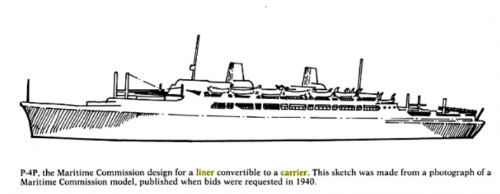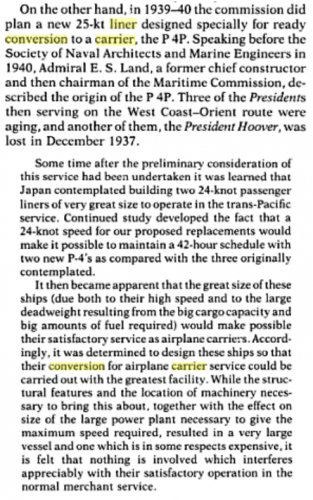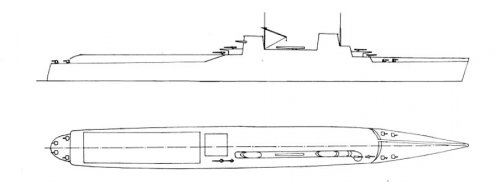A proposal was made by the U.S. Navy, under War Plan ORANGE (war with Japan), for the conversion of fast ocean liners to aircraft carriers in time of war with Japan. Since the conversion would take at least six months, and the liners would be needed for troop transport (especially in a Pacific campaign), the XCV proposal came to nothing.
However, United States Lines proposed in the autumn of 1927 building at least two high-speed ocean liners for trans-Atlantic service, with military conversion simplified. The vessels would have a 3/4 length flight deck, and funnels offset to the starboard side. Two 18-plane squadrons (scouts, fighters, fighter-bombers, or torpedo bombers) could be carried; a single centerline elevator would be fitted. Actual military equipment (mostly the guns, naval aircraft and the aft-most portion of the landing deck) would only be installed when the vessel was brought into naval service. A catapult is mounted extending forward from the flight deck; another traversable catapult is mounted on the island, for launching float-equipped airplanes.
In civil service, a few mail planes would be carried, to be launched when the ship came within easy range of land. Some cargo -- such as automobiles -- would be carried in the hangar space; the hangar space aft of the elevator would be left open to the sky, and landings aboard would probably not be made. Probably only 500 - 800 passengers would be carried.
The Navy Department drew up plans for the vessel, in coordination with United States Lines, by 18 July 1928; but the U.S. Shipping Board by then had already rejected the plan in April. Large government subsidies and loans would have been needed. Naval interest in the project continued until the stock market crash of 1929 prevented United States Lines from further participation. Likely names would have been S.S. Manhattan and S.S. Washington.
The "New Deal" legislation of 1933 includes funds for building two carriers, the Yorktown and Enterprise; two other carriers, the Lexington and Saratoga, were built in the Twenties as conversions from incomplete battlecruisers.
Length 980', beam 100', displacement about 33,000 tons.
Speed 33-36 kts from turbines on 4 shafts; range 11,000 nautical miles at 18 kts.
Armament: four open mounts with single 6" Mark 12 guns; eight open mounts with 5"/25 caliber AA guns.
Crew: 1,000 in military service (including aviators and Marines)



